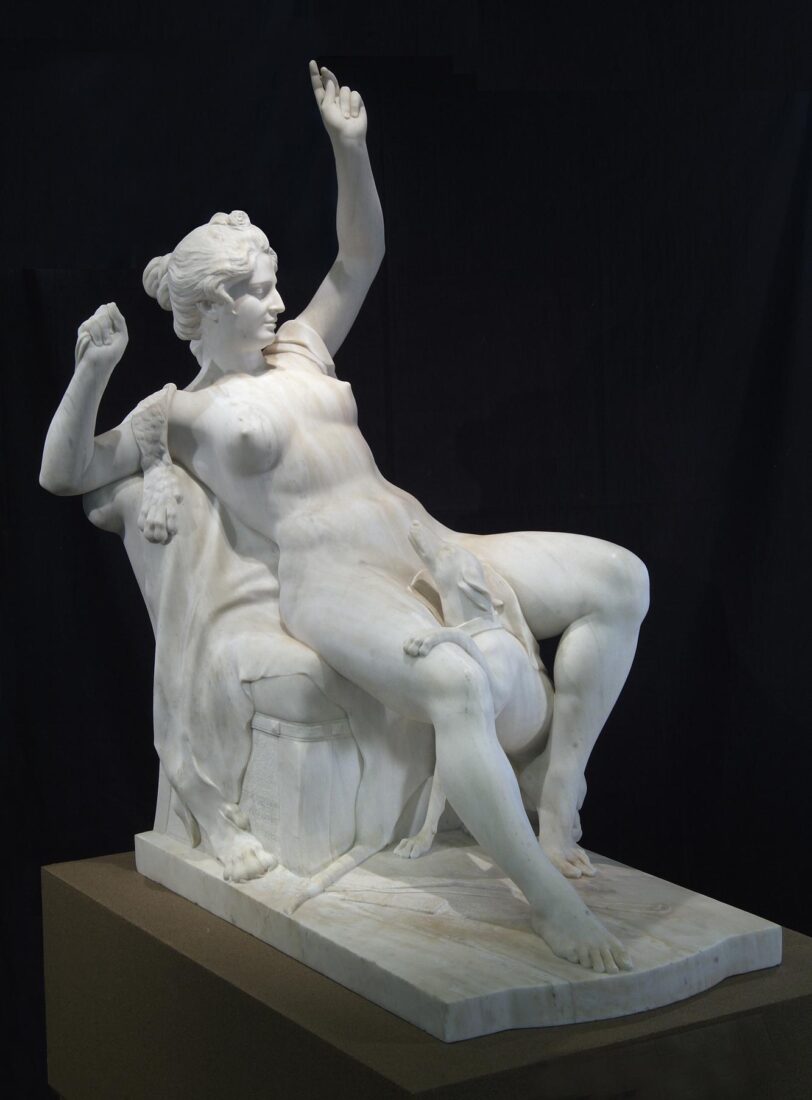Ioannis Vitsaris studied at the School of Arts and completed his education in Munich. Despite his neoclassical education, returning from Munich in 1871, he engaged in realistic compositions, both in terms of content and style, often much bolder than those of Dimitrios Filippotis, who was the first to introduce realistic themes into modern Greek sculpture.
“Christos, the Black Guy” belongs to this category. Christos was a characteristic figure of Athens, who lived mainly on the streets and died in 1886. He was especially beloved, while he was a model in works by the painters Nikephoros Lytras and Nikolaos Gyzis.
Vitsaris made the work in 1874, with a very realistic style, which is reflected in the posture of the body and the rendering of details, while the painted plaster creates the impression of dark skin. In 1875 he presented it at the Olympia exhibition, where he won the bronze medal. But despite the award, it was described by the critics as an “unfortunate idea”. Despite the negative reception, however, “Christos, the Black Guy” is an exceptional, and early, sample of realism in modern Greek sculpture, without concessions in the neoclassicist direction.
Georgios Vroutos’ “The Boy with the Crab” continues the tradition of the nude child in nature that was introduced by Dimitrios Filippotis in 1870. Vroutos was a sculptor with a genuinely classical education. At the same time, however, he was interested in compositions with realistic content, which were designed to decorate public and private gardens.
“The Boy with the Crab” combines the artist’s classical influences with a realistic rendition. The naked boy has just emerged from the sea and is holding his mantle. Terrified by the sight of the crab, he is leaning backward in an effort to strike the crab with the stone he holds in his broken right hand.
The composition is characterized by the smooth refined modeling of the childish body, the harmonious proportions and the successful adaptation of a rather rare subject as an image of daily life.
The realistic and at the same time psychographic rendering of the depicted person in busts, which had already come to dominate Europe, pricked the interest of Filippotis as well, who during the period 1864-1870 was continuing his studies in Rome.
The bust of Eirene Abanopoulou, a beautiful young woman, is rendered in a practically generalized manner in regard to her nude upper chest and shoulders, which are moulded with soft curves and slight protrusions and depressions of the marble surface, but with an especially dexterous manner in the rendering of the smooth and vibrant young flesh. The sculptor’s realistic approach is expressed most clearly in the rendering of the natural features, seen in the delicate eyebrows, the pupil and iris of the eye, the fine, well-proportioned nose and the small mouth, as well as the lacy border of the dress with the low neckline. This rendering reaches its crowning point in the elaborately worked hair-style, with the long braid wound around her head like a crown.
Georgios Bonanos lived in a period of transition for modern Greek sculpture. It was a time when a number of artists had begun abandoning neoclassical styles and subject matter in favor of realism.
“Nana” is a daring composition, inspired by Emile Zola’s novel of the same name. It displays the influence of this particular literary work on Greek art as well as Bonanos’ shift towards realistic subject matter. Nonetheless, the rendition remains neoclassical. The marble surface is highly refined and the heroine is depicted nude with a tranquil face that is almost indifferent to her body’s sensual pose.
Bonanos showed this work in 1900 at the Paris Exhibition, where it won the bronze medal. In 1938 he exhibited it in the Panhellenic exhibition at the Zappeion in Athens. Bold for its time, it provoked considerable debate. At any rate, the sculptor later changed the title to “Huntress”. This change was probably due to Bonanos’ Hellenocentric ideology, but also could have been his attempt to avoid scandal. Nonetheless, the dog, the lion’s skin, and the bow and quiver associate the young woman with Artemis, Goddess of the Hunt, “mistress” and “enchantress” of animals, who here becomes the temptress of men.







